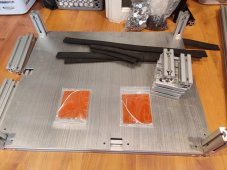Snowynorth
New Member
- Joined
- Jan 10, 2022
- Messages
- 177
Horsefly, I wish I had your skills. I don't, but I can frame. I'm building a 10 x 12 shed out of 2x8 that I have, and insulating it with 8" rockwool that I also have left over from our cabins' build. I'm installing 2 wall mount low btu, direct vent wall heaters with wall mount thermostats. One set to come on at 40f +- and one set at about 35+- for redundancy. I have propane and wiring to pv and cabin already trenched in to the shed site. I'm going to forward this thread to the electrician I know. I'm sure he could help a few people that don't have the luxury of propane roughed in for a solar shed. My shed is going to have a small area framed and wrapped with hardware cloth in the corner, with a feeder, and a small cat door, for a couple feral cats, to keep them warm enough, and, to keep the mice at bay. Thanks for sharing.




